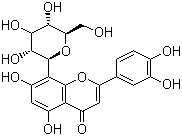Description:
Orientin, found in the herbs of Polygonum orientale Linn, exerts antidepressant-like effects on CUMS mice, specifically by improving central oxidative stress, neurotransmission, and neuroplasticity. Orientin protects vascular barrier integrity by inhibiting hyperpermeability, expression of CAMs, and adhesion and migration of leukocytes, thereby endorsing its usefulness as a therapy for vascular inflammatory diseases. Besides, Orientin may be regarded as a candidate therapeutic agent for treatment of vascular inflammatory diseases via inhibition of the HMGB1 signaling pathway.
- Molecular Weight: 448.38
- Molecular Formula: C21H20O11
Purity: >98%
Canonical SMILES:
C1=CC(=C(C=C1C2=CC(=O)C3=C(O2)C(=C(C=C3O)O)C4C(C(C(C(O4)CO)O)O)O)O)O
InChI:
InChI=1S/C21H20O11/c22-6-14-17(28)18(29)19(30)21(32-14)16-11(26)4-10(25)15-12(27)5-13(31-20(15)16)7-1-2-8(23)9(24)3-7/h1-5,14,17-19,21-26,28-30H,6H2/t14-,17-,18+,19-,21+/m1/s1
InChIKey: PLAPMLGJVGLZOV-VPRICQMDSA-N
- Appearance: Yellow powder
- Application: Antidepressant
Synonyms:
8-b-D-Glucopyranosyl-3,4,7-tetrahydroxyflavone; Luteolin 8-C-b-D-glucopyranoside; Lutexin
More details are to be found on supplier website
